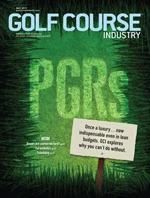Recently, a well-known golf commentator told me that equipment advances make average golfers better, but the player’s average handicap remains the same because new golf courses are much harder to play. I hadn’t even considered that possibility, believing that as long as the average putting improvement infomercial lasts longer than typical practice putting (and short game) sessions, average golfers won’t improve scoring. Nonetheless, it’s a subject worth exploring. There is some debate as to whether golf needs to be harder or easier to captivate new players and re-energize old ones. Most in the golf business would vote for “easier.” Women in particular – especially those in professional positions – say the fear of looking bad – both in golf and fashion, which is a whole different discussion – holds them back. There is little doubt that our current golf courses are “not your father’s golf course.” Conditions, the “golf experience” and overall design interest are better. But, if we have made them tougher in an era of broadened golf demographics, then they aren’t your mother, wife or child’s course either. Given 16,000 golf courses, drawing conclusions requires some “shameless” generalization about courses then and now, but it seems there are some ways golf is harder and others where it’s easier than in “days gone by.” Private clubs are probably similar, although where greens committees are dominated by low-handicap players, certainly some have toughened up over time. Others, though, have naturally narrowed as a result of nature and the tree planting committee, while greens have gotten both faster and smoother, probably balancing them out between eras. Bunkers today are easier by most accounts. The difficulty of public courses has probably increased in the “Upscale Public Era.” Design was driven by “one-upmanship” and building a “better mousetrap,” which was defined as harder, more photogenic – i.e., more bunkers, longer, award-winning and highly-rated courses – and all were probably difficult for average players, who nonetheless were willing to ante up for the experience. On the other hand, older courses are often typified by smaller “domed” greens that couldn’t have been easy to hit and hold, and overall, turf conditions on fairways, rough and greens would were probably harder on average scores. Generalizations aside, average golfers only care whether their course is too hard. I have been promoting shorter golf courses for a while. But design features can make courses too difficult for average golfers, too. Some quick fixes – other than adding forward tees – might include:
There’s an old joke about a man who goes on an incredibly cheap world cruise, only to find he’s chained down and working the boilers, while occasionally being allowed to look out the port holes at famous places. He asks the guy next to him if they will ever get a break, and gets the reply “Well, they didn’t last year!” No doubt that some modern courses are asking golfers to come back for more torture and wondering why play is down. Some common sense changes may increase the fun quotient that golfers will gladly pay for. GCI |

Explore the May 2011 Issue
Check out more from this issue and find your next story to read.
Latest from Golf Course Industry
- ’Twas the Night Before Christmas (on turf)
- Twas the Night Before Christmas (the turf version audio)
- Advanced Turf Solutions and The Aquatrols Company release soil surfactant
- Heritage Golf Group acquires North Carolina courses
- Editor’s notebook: Green Start Academy 2024
- USGA focuses on inclusion, sustainability in 2024
- Greens with Envy 65: Carolina on our mind
- Five Iron Golf expands into Minnesota





